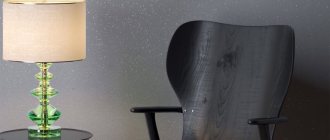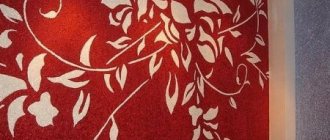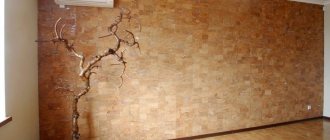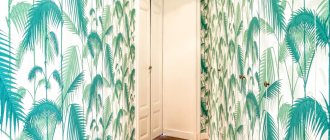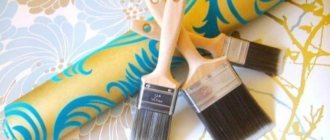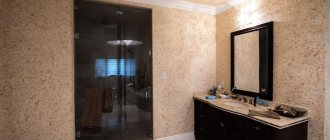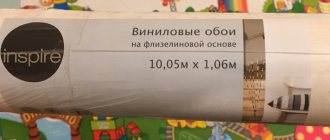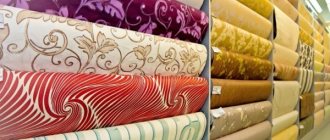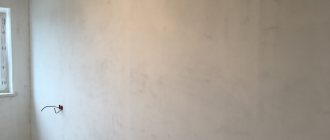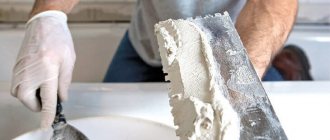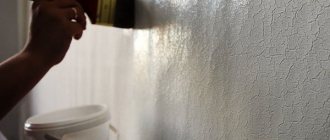Repair is not an easy task. Even if the work will be carried out not by you, but by hired people. After all, one of the most difficult stages is creating a design and selecting materials. And now making a choice has become even more difficult - of course, in a good way, because a wide variety of materials gives so many possibilities. This is especially true for wall coverings. Even if you opt for wallpaper, there are also a great variety of material options. First of all, wallpaper can be divided into paper, vinyl and non-woven. Canvases with 3D patterns and wallpaper with glitter stand out separately.
Types of wallpaper with glitter
Glitter wallpaper comes in different types.
- Paper wallpaper. Foamed acrylic is applied to their surface. There are two ways to make this material shine. The first is to add a substance that reflects light to the acrylic while making the paste. Another option is to apply acrylic to the paper first and then sprinkle glitter on it. Then the surface will become a little voluminous. As a rule, it is not entire canvases that are made textured, but individual elements of the design. This wallpaper is the most inexpensive and fragile.
- Vinyl wallpapers. When preparing the mixture from which the canvas is made, sparkles are added to it. Thus, reflective materials appear not only on the surface, but permeate the entire canvas.
- Non-woven fabric is usually used as a base for vinyl wallpaper. There are also non-woven ones, but they are usually painted independently. And you can add shine to them at this stage - just buy glitter at a hardware store. Add them to the paint and apply it as usual. You can also find paint that already contains glitter.
- And one more type - liquid wallpaper with glitter. The mixture can be purchased or made independently. Glitter is added to the composition at the stage of preparing the mixture itself.
Interior styles with white wallpaper
Canvases made in light colors will be the ideal backdrop for creating various styles. They will add notes of sophistication and sophistication to a modern room, and also add light and comfort to the room.
Minimalism
Minimalism is characterized by light walls and ceilings. All furniture is made in simple geometric shapes. It is better not to clutter the room with additional interior items. The resulting room will be laconic and discreet.
Neoclassical
White wallpaper with a silver pattern will fill the room for which it is chosen with nobility and sophistication. The patterns combine the spirit of antiquity and timeless classics. Despite the unusual appearance of the paintings, the setting will not look like a museum. The room will be filled only with home comfort.
Provence
The white shade is an integral part of this style direction. It can serve as the main background, which will highlight the advantages of delicate and pastel tones of green, blue, and beige. With the help of Provence, a calm and peaceful atmosphere is created in the room.
Shabby chic
White wallpaper, chosen to create a shabby chic feel in the room, complemented by floral designs in silver tones, combines vintage notes with romanticism. Canvases are appropriate to use in rooms with different functional features. The main thing is to choose the appropriate furnishings for them, as well as other interior items.
Modern
A variety of floral prints look good on white Art Nouveau wallpaper. They can be big or small. This depends on the size of the room where these canvases are selected.
Scandinavian style
It is characterized by maximum simplicity. Therefore, it is better to use white wallpaper with a silver pattern only on 1 or 2 walls. This will help to place the right accents in the room, and also not to overload it with unnecessary decoration. Scandinavian style will convey all the naturalness of the interior, creating coziness in it.
White wallpaper with a silver pattern is a universal finishing material that will organically fit into any style of residential or office space. If you need to diversify too light walls, then you can use furniture, textiles or other interior items that will be decorated in brighter and richer colors.
Types of glitter
There are also different types of sparkles.
- White. They are not colored by anything, and until light reaches the surface, the glitter will not reveal its presence. But under the influence of light, these particles begin to shimmer.
- There are also sparkles of dark colors. They are applied, accordingly, to dark surfaces. Not everyone risks choosing this room design, but it looks very beautiful.
- Sparkles of light colors. Most often they are the same color as the drawing itself. But they may differ.
Combination of other colors in the interior: tips
You can also apply glitter to a painted wall.
This is an easy way to decorate, you can do it yourself without involving professionals. Wallpaper completely covered with sparkles is not used for all walls of the room; such a room will be overly luminous. They are combined with wallpaper that is similar in color.
When choosing rolls in a store, it is advisable to take several fragments and see how they will look in the room under artificial and natural light.
When choosing, you need to pay attention to the quality - if, after running your hand over the surface, sparkles remain on it, it means that after gluing, part of the decor will fall off.
Glitter on walls has only recently begun to be used, but its effectiveness attracts both ordinary citizens and designers. With their help, you can create an accent in the room and smooth out minor imperfections in the wall.
Characteristics of liquid wallpaper
When choosing a wall covering, try a rather unusual option - liquid wallpaper. They look especially interesting with glitter. But they also have other advantages.
- The application technology itself is simpler than that of conventional rolls: you do not have to spend a lot of time calculating the required amount of material, applying it to the wall, getting rid of bubbles and cleaning the canvases from glue.
- One of the main problems that people encounter when covering walls is joints. You have to spend a lot of time to ensure that the borders of the canvases are invisible. When applying a liquid mixture, such difficulties do not arise.
- Also, applying regular wallpaper requires a lot of free space - the rolls have to be laid out on the floor in order to cut the required piece. When working with liquid wallpaper, you need very little space.
- It is not at all necessary to use one color - this type of wallpaper allows you to create different combinations and unusual designs yourself.
- This coating is more wear-resistant - it will last on the walls for more than ten years.
- Damage on such walls is very easy to fix.
True, liquid wallpaper with glitter also has some disadvantages:
- they are more expensive than other types;
- they cannot be cleaned using water - the stained area must be removed, soaked and reapplied.
Room styles
As a selection of photos of white wallpaper demonstrates, they go perfectly with any interior style. Moreover, the use of this color helps to unload the room and avoid over-stylization.
- The classic interior itself involves the use of white. It can be complemented with light or dark wood furniture and molded false columns.
- Modern also involves the use of neutral tones. Here, white will go well with patterns of contrasting tones and geometric shapes.
- Scandinavian style involves a large number of options for brown and beige, which can make you tired. White will bring freshness and light to such an ensemble.
- Oriental style with a lot of white will make the interior festive and unusual. Most oriental interiors are decorated in languid colors, which adds heaviness. And white in a composition with silver arches, blue or pink paisley patterns on textiles and abundant brocade fringe and tassels will look amazing.
- For a high-tech style, this color must be used very carefully. Large amounts of white, clear glass, glossy surfaces and chromed metal can create a hospital feel.
Preparing the mixture
It is important to know a few rules for applying liquid wallpaper with glitter.
- A mixture for liquid wallpaper, as a rule, consists of several elements. First of all, you need to stir the dry ingredients. But at this stage you don't need to add glitter. The main thing is to thoroughly rub the powder with your hands to get rid of lumps.
- Pour water into a separate container. Glitter for liquid wallpaper is added to the water at this stage. Only with this sequence of actions will they be evenly distributed in the mixture.
Important!
Be sure to read the manufacturer's recommendations regarding water temperature. As a rule, it should not exceed thirty-five degrees.
- Pour the powder into water. Stir the mixture with your hands while wearing rubber gloves. Do not use any tools (like a construction mixer), because this will cause the mixture to have the wrong consistency. The result of using such a composition is unpredictable.
- The main thing is to add the powder to the water immediately after opening the package and stirring it.
- The powder mixed with water should sit for twelve hours (or less, depending on the specific manufacturer).
Decorative varnish - shine and protection for your plaster!
Decorative plaster does not require additional processing - it is classified as a finishing coating and forms a durable, aesthetic surface. However, if you want to emphasize the texture, add shine and add shades, special glazing compounds are used. In this article we will look at what finishing varnish is used to cover walls, how to prepare it yourself and what to apply it with.
What is a glaze composition
Glaze varnish is a coating designed to improve the decorative properties of a material. It is used on smooth and textured plasters, forms a durable transparent film, gives the desired shade and/or shine. It does not hide the color and texture of the plaster, but only emphasizes its relief.
Glazing varnish is used for:
- Improving the appearance of the coating. Different types of composition and application techniques give different effects: to emphasize the relief structure of the material, to give a pearlescent shine to the coating, to give the wrong color of plaster the desired shade.
- Protection. After drying, the composition forms a vapor-permeable film, which enhances the strength of the main decorative coating. Plaster treated with varnish is more resistant to mechanical stress, is not afraid of dampness, and does not fade under the influence of sunlight. Dust settles less on uneven surfaces, and if necessary, the wall can be washed. Finishing with plaster in wet rooms (bathrooms) must be completed with final varnishing.
The composition is environmentally friendly and can be used for finishing residential premises.
Below in the photo you can see how decorative plaster coated with varnish looks in different colors.
What varnish to cover the walls with?
Glazing varnish is a water-based acrylic solution + targeted additives. Available in 2 options:
- colorless - used unchanged or tinted independently;
- colored - completely ready for use; you cannot add paint or dye to it.
The composition may contain glitter, and the surface covered with it becomes pearlescent.
Glazing varnish, depending on the type, can be matte, semi-gloss or glossy.
Almost every manufacturer of decorative plaster also has a varnish for coating it. But it is not necessary to use materials of the same brand; you can choose any, for example, VGT, San Marco, Perlacheo, Tex, Poliver, Dali, Bayramix, etc.
How to tint varnish
If you can’t choose a color from ready-made compounds, you can purchase a colorless one and get the desired shade yourself. To give the desired color, special solutions are used - tints. Additionally, you will need scales, a mixing container and a drill with a mixer attachment.
- Pour the required amount of varnish into a container and weigh it.
- The maximum allowable amount of color is 10% of the base. It is advisable not to pour out all the paste at once, but add in small portions and then stir.
- Then apply the liquid to a sample of the coating and wait until it dries to evaluate the result.
It is important to remember that acrylic compositions may darken slightly after drying.
How to make it yourself
Glazing compounds are produced by different manufacturers, but most of them are expensive. If you want to save money, you can prepare the solution yourself.
Necessary materials for making glaze with your own hands
- scales;
- wallpaper glue;
- acrylic panel varnish (matte or glossy, depending on what kind of coating is required);
- drill with mixer attachment;
- container for mixing the solution;
- color or water-based paint;
- additives (sparkles - glitter).
Recipe. The glaze solution (glaze) will consist of 2 parts glue, 1 part varnish and ½ part paint.
- First, prepare the glue by diluting the dry powder according to the instructions indicated on the package. Mix thoroughly and leave until the flakes are completely dissolved in the water. It is not advisable to store the prepared liquid for a long time, so you need to calculate the required volume and prepare as much as you need for work.
- Panel varnish is poured into a container with ready-made glue and mixed thoroughly.
- Then paint is added. If you use color, then pour in a smaller amount (not ½ part).
- At the same time, add glitter. Add very little additives - a few grams per 1 kg of solution is enough.
This recipe is not the only one. It is quite possible to do without wallpaper glue, for example, using only acrylic varnish, diluted 1:1 with water and tinted with color. If you do not add water, you will end up with a too thick glossy film on the plaster.
Application (glaze)
The glazing composition is applied to completely dry plaster. If there is dust on the surface (from grouting, for example) or dirt, remove it. Decorative finishes are varnished without preliminary priming; there is no need for it.
When carrying out work, the humidity in the room should not exceed 75%, and the temperature should be from +5 to +35 °C. When the primer layer has dried, begin application.
Application methods: sponge, roller, paint brush or spray gun.
Methods for glazing plaster
Important! The solution containing glitter must be stirred constantly so that the additives do not settle to the bottom of the container.
- Work starts from the corner. The wall is mentally divided into squares with an area of 1 m². First, they process one, then immediately move on to the next, not allowing the first area to dry out. If you take breaks, the liquid will dry out and the transitions will be noticeable. There is no way to fix this.
- If the liquid has thickened, or you need to get a light, almost invisible coating, the liquid is diluted with water. The composition has virtually no odor during application and dries quickly.
- The composition is applied in separate strokes, without trying to completely paint the surface. Movements can be straight or circular, randomly directed. After treatment, even before the liquid dries, you need to shade the surface. Since the solution dries quickly, it is recommended to work together: one applies the composition, the other shades it.
Drying time depends on the specific composition, on average 1-2 hours.
Material consumption: about 100 g per 1 m². When using a spray gun, consumption is reduced.
If the goal is to create a light coating or additional protection for the plaster, then one layer is enough. The second is applied when it is necessary to give the surface greater color saturation. An additional layer can be made either with the same solution or with a different color. Between applications take a break of 1-2 hours.
How to apply the composition?
Applying liquid wallpaper to walls is quite simple. Several tools will come in handy:
- Master OK;
- plaster float;
- putty knife.
Advice
There is one way to prolong the life of the coating and fix it more reliably - to cover it with a thin layer of acrylic varnish. It can be applied using a spray bottle.
Apply wallpaper using a trowel. The layer of composition should be about three millimeters thick. Distribute the mixture into small areas. Apply approximately one square meter of the mixture, and then level it with a plaster float soaked in water.
The wall will dry within three days. Only after complete drying can it be varnished.
If you want to create a pattern or even a specific design on the wall, take care of this in advance. You need to draw the drawing with a pencil. And then imagine that in front of you is an ordinary children's coloring book - and you can create.
Removing wallpaper from the wall is also very easy. You need to moisten them with hot water (soak a rag, sponge or broom with the liquid). The mixture will become soft and you can get rid of it with a spatula. This makes it easy to remove even a small area of the coating.
How to decorate a wall with glitter
Have you seen interesting rooms in which one wall is painted a different color or has a special design applied to it? You can go a little further and make one wall sparkle or shimmer with glitter, small sparkles made from polyester film. Using our instructions, you can make the wall have a subtle shimmer or a high shine, depending on your preference. You can decorate a wall in this way in a children's room, in a bath or in a bedroom.
What you will need: - PVA glue or PVA with acrylic varnish; - 600g regular size rainbow glitter; - 320g very small rainbow glitter; - 120g largest size rainbow glitter; - 150g very small pink glitter; - foam brush with wooden handle;
Step 1: Mix Glitter Once the wall is painted the base color, start finishing. Mix glue with different sizes of glitter. For a wall measuring 2.6 m x 5.2 m you need approximately 1.9 liters of glue and 1200 g of glitter.
Start by pouring a cup of glue into the container. You need to take the glue one cup at a time so that it does not dry out prematurely.
Add glitter to the container.
Using the handle of a brush, stir the mixture.
Add as much glitter as you like. At the end, the mixture should look like cement and flow slowly from the brush.
Tip: Before you start painting the wall, cover the floor to prevent glue from dripping onto it. If a leak does occur, wait until the mixture dries and then use a paint scraper to remove any adhesive. Any remaining stains can be cleaned with a hoe and warm, soapy water.
Step 2: Apply the mixture to the surface Using a foam brush, spread the mixture over your prepared wall.
The big advantage of this project is that it does not require any special skill. You do not have to cover the wall completely evenly, as long as the coating is not too thick and does not contain lumps. Once you've covered the wall with the glitter mixture, let the layer dry for about five hours.
Tip: The mixture will appear white at first, but as it dries, only glitter will be visible.
Step 3: Touch up the wall where necessary
When the first layer is dry, go through and touch up those areas that look pale compared to the rest of the wall. Make the same mixture as for the first layer, but a little thinner. Use the same brush as for the first layer.
Step 4: Decorate the Room After the last layer has dried, arrange the furniture. Now you have such a unique wall in your room that everyone will be jealous!
A great way to add elegance to your apartment design!
Conclusion
There are many ways to create an unusual room design. One of them is to choose interesting wallpaper. Fortunately, it’s easy to find a unique option - after all, there are so many different types of canvases. And one of the innovations is wallpaper with glitter.
Glitter is added both to regular paper, vinyl and non-woven wallpaper, and to liquid wallpaper. The last option is the most original. Liquid wallpaper with glitter is somewhat more expensive than regular wallpaper, but it is very easy to apply, and the result will please everyone.
How to prepare liquid wallpaper for use and apply it correctly to the wall?
Types of designer wallpapers and their advantages
How to make liquid wallpaper with your own hands?
Results
In some cases, glitter on the wallpaper will only be visible in the light
Every reader now understands that wallpaper with glitter can be used everywhere - and the result will be a high-quality and very pleasant design in the room. The main secret of a successful interior with such decoration is to strictly monitor the balance, because no one wants to receive an overly sparkling, awkward room as the result of their work.
The video will help you cope with the task and will greatly facilitate the choice of facing material with reflective elements.
A beautiful interior in which you will feel comfortable is quite possible. Anyone can achieve the desired result with their own hands. If you choose materials from domestic manufacturers, you will also be able to significantly save on surface cladding.
